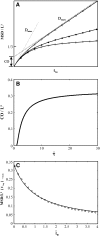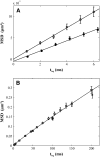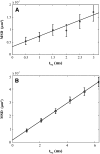(Un)confined diffusion of CD59 in the plasma membrane determined by high-resolution single molecule microscopy
- PMID: 17325009
- PMCID: PMC1853144
- DOI: 10.1529/biophysj.106.095398
(Un)confined diffusion of CD59 in the plasma membrane determined by high-resolution single molecule microscopy
Abstract
There has been emerging interest whether plasma membrane constituents are moving according to free Brownian motion or hop diffusion. In the latter model, lipids, lipid-anchored proteins, and transmembrane proteins would be transiently confined to periodic corrals in the cell membrane, which are structured by the underlying membrane skeleton. Because this model is based exclusively on results provided by one experimental strategy--high-resolution single particle tracking--we attempted in this study to confirm or amend it using a complementary technique. We developed a novel strategy that employs single molecule fluorescence microscopy to detect confinements to free diffusion of CD59--a GPI-anchored protein--in the plasma membrane of living T24 (ECV) cells. With this method, minimum invasive labeling via fluorescent Fab fragments was sufficient to measure the lateral motion of individual protein molecules on a millisecond timescale, yielding a positional accuracy down to 22 nm. Although no hop diffusion was directly observable, based on a full analytical description our results provide upper boundaries for confinement size and strength.
Figures










Similar articles
-
Determination of the Membrane Environment of CD59 in Living Cells.Biomolecules. 2018 May 17;8(2):28. doi: 10.3390/biom8020028. Biomolecules. 2018. PMID: 29772810 Free PMC article.
-
Revealing the Raft Domain Organization in the Plasma Membrane by Single-Molecule Imaging of Fluorescent Ganglioside Analogs.Methods Enzymol. 2018;598:267-282. doi: 10.1016/bs.mie.2017.06.038. Epub 2017 Oct 31. Methods Enzymol. 2018. PMID: 29306438
-
Both MHC class II and its GPI-anchored form undergo hop diffusion as observed by single-molecule tracking.Biophys J. 2008 Jul;95(1):435-50. doi: 10.1529/biophysj.107.123018. Epub 2008 Mar 13. Biophys J. 2008. PMID: 18339737 Free PMC article.
-
Dynamics of raft molecules in the cell and artificial membranes: approaches by pulse EPR spin labeling and single molecule optical microscopy.Biochim Biophys Acta. 2003 Mar 10;1610(2):231-43. doi: 10.1016/s0005-2736(03)00021-x. Biochim Biophys Acta. 2003. PMID: 12648777 Review.
-
Quantitative microscopy: protein dynamics and membrane organisation.Traffic. 2009 Aug;10(8):962-71. doi: 10.1111/j.1600-0854.2009.00908.x. Epub 2009 Apr 4. Traffic. 2009. PMID: 19416480 Review.
Cited by
-
A random motility assay based on image correlation spectroscopy.Biophys J. 2013 Jun 4;104(11):2362-72. doi: 10.1016/j.bpj.2013.04.031. Biophys J. 2013. PMID: 23746508 Free PMC article.
-
The molecular size of the extra-membrane domain influences the diffusion of the GPI-anchored VSG on the trypanosome plasma membrane.Sci Rep. 2015 Jun 11;5:10394. doi: 10.1038/srep10394. Sci Rep. 2015. PMID: 26065579 Free PMC article.
-
Tracking Single Molecules in Biomembranes: Is Seeing Always Believing?ACS Nano. 2019 Oct 22;13(10):10860-10868. doi: 10.1021/acsnano.9b07445. Epub 2019 Oct 7. ACS Nano. 2019. PMID: 31589406 Free PMC article. Review.
-
Imaging FCS delineates subtle heterogeneity in plasma membranes of resting mast cells.Mol Biol Cell. 2020 Mar 19;31(7):709-723. doi: 10.1091/mbc.E19-10-0559. Epub 2020 Jan 2. Mol Biol Cell. 2020. PMID: 31895009 Free PMC article.
-
Cholesterol slows down the lateral mobility of an oxidized phospholipid in a supported lipid bilayer.Langmuir. 2010 Nov 16;26(22):17322-9. doi: 10.1021/la1026202. Epub 2010 Oct 13. Langmuir. 2010. PMID: 20942393 Free PMC article.
References
-
- Sharma, P., R. Varma, R.C. Sarasij, Ira, K. Gousset, G. Krishnamoorthy, M. Rao, and S. Mayor. 2004. Nanoscale organization of multiple GPI-anchored proteins in living cell membranes. Cell 116:577–589. - PubMed
-
- Simons, K., and E. Ikonen. 1997. Functional rafts in cell membranes. Nature. 387:569–572. - PubMed
-
- Munro, S. 2003. Lipid rafts: elusive or illusive? Cell. 115:377–388. - PubMed
Publication types
MeSH terms
Substances
Grants and funding
LinkOut - more resources
Full Text Sources
Other Literature Sources
Miscellaneous

